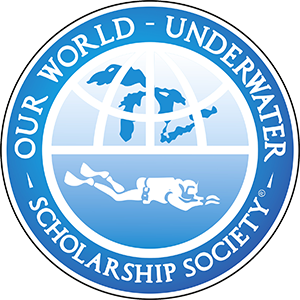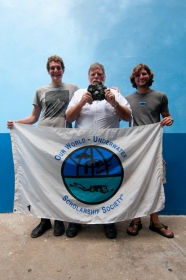I first met Charlie Beeker at the annual OWU scholarship reception in New York. He mentioned he wanted to get the current scholars down to his field site in the Dominican Republic at some point during the scholarship year on an archaeological fieldwork trip. Naturally my eyes proceeded to bulge out of my head with the prospect of going there, let alone diving historical archaeological sites! Let me tell you when you’re from New Zealand the Dominican Republic can seem a world away. After a stunned silence I enthusiastically said I would love to join him down there, little did I know it was to turn into the one of the most exciting weeks of my life.
Charlie is an archaeologist and the director of the Office of Underwater Science at Indiana University. He was Josh Stuarts (2010 North American Scholar) honours supervisor and the two of them have worked closely together on Charlie’s long-term project dubbed ‘Living Museums in the Sea’. Josh and I were to head down to the Dominican Republic with Charlie for a week to help him undertake a rapid assessment of his sites, some coral restoration work, and general site maintenance.
The ‘Living Museums in the Sea’ project aims to increase understanding and appreciation of submerged cultural heritage of the country in question (currently only based out of the Dominican Republic but as you will soon see there is no reason why it can’t be applied the world over). This is of particular importance in developing countries as the revenue that these historical sites create is hugely beneficial to the local economy. In the Dominican Republic it is far easier arranging for protection of cultural heritage sites over marine protected areas, therefore with the ‘Living Museums in the Sea’ project historical sites are transformed into artificial reefs by the reintroduction of artifacts in replica form, such as cannons from the original Captain Kidd wreck or the Morales site (two sites that we focused on throughout our trip). Protection of the historical site is achieved as is the surrounding reef that has been created. Furthermore, divers can then be taken to these site and learn a great deal about the cultural heritage of the country they are diving in while simultaneously being present on the actual site!
The cultural history that lies in wait under the waves in the Dominican Republic is astonishing! Pre-historic human and faunal remains at Taino Indian offering sites, 16th Century shipwrecks, the only known pirate shipwreck in the Caribbean, a flooded cave system which hosts a bounty of significant archaeological artefacts, and that’s not nearly naming them all. It’s the perfect setup for a project such as Charlies and boy did he have some exciting stuff lined up for Josh and myself.
Our main priority was conducting the rapid assessment, just as the name suggests it was a quick full three days diving, assessing the condition of three of Charlie’s main sites. the GUAP, Morales, and Captain Kidd Living Museums in the Sea (LMS): one shipwreck and two mock-shipwrecks. The sites are marked by a main buoy with a mooring buoy nearby for boats to moor easily to the site. Our job was to go down to each site noting any changes from the previous assessment, any ideas on future improvements and general site maintenance such as repairing broken buoys, usually smashed up by speeding boats not watching where they are going. The fashioning of the buoys was in itself lots of fun. We created them out of large PVC pipe from the local hardware store and other bit and pieces we could scrounge. Each buoy was marked as a LMS site, and tastefully plastered with Indiana University, DAN, and shipwreck stickers. They were quite the art form once we were finished with them.
Fashioning our buoys
Attaching the buoys and a bit of a site survey
The Captain Kidd site is home to a large number of endangered Acropora palmata colonies. Often damaged by boating activities the large colonies are easily felled or smashed apart by a wayward anchor. One of our tasks was to undertake some coral restoration work. We would right rolled over colonies or reattach broken branches to living substrate. A few years ago Charlie and some of his students experimented with a reattachment method using cable ties to attach living broken coral branches back onto the main coral structure. They took to it surprisingly well by calcifying back to main colony even growing up over the extending cable tie and forming a new branch. We continued on with this method mending a number of smashed colonies hopefully back to a healthy state.
Our last day diving had us complete the rapid assessment and with the afternoon free Charlie took us on a trip that I will never forget. The Padre Nuestro cavern is a hugely significant archeological site. The cavern is reached by driving into the jungle a small ways down a dirt track, someway along there is a guard house in which it took much haggling in broken Spanish, wild hand gestures, and phone calls before the guard would let us in. Once through the gate you arrive at a small path that you walk down to a small tranquil pool. On the far side of the pool there is a small horizontal gash like entrance to the cave system only a few feet high. Upon entering one could be forgiven for feeling a sense of vertigo, with water clarity so clear it give the illusion of flying, it was a sensation I will never forget. The cavern itself is astounding; formerly a dry cave, spectacular stalagmites and stalactites line the walls and ceiling, making the now flooded cave, world class purely from an aesthetic point of view. From an archeological standpoint the cavern is priceless, in an area no larger than half a tennis court there are two species of extinct primates, two extinct sloths, lithic tools, and Taino Indian water gather pots and sacrifices. Absolutely spectacular!
With our work done we packed up and headed back to the capital Santo Domingo. Here Charlie took us to the Oficina Nacional del Patrimonio Cultural Subaquatico, a government archeological office that Indiana University is closely affiliated with. There they have an amazing array of artifacts relating to the Dominican Republic’s history. Just some of the things we were privy to see included perfectly intact dueling pistols, cannons, a number of Taino drinking vessels, and a sack of silver coins cemented together amazingly still holding the shape of the sack they were originally in.
From left: Myself, Charlie Beeker, and Josh. Charlie is holding the silver coins found cemented together
I felt I gained a wealth of knowledge from my experience with Charlie, packing more diversity and activities into our six days on the Dominican Republic than I could have ever imagined. It’s not every day you can say to someone you dove two historical shipwrecks, an archeological cavern site and then topped it off with a night dive on the house reef, all in one day! It was a true adventure!















